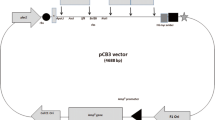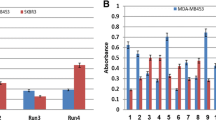Abstract
Inappropriate expression of the receptor tyrosine kinase Met and its ligand hepatocyte growth factor (HGF)/scatter factor (SF) is usually associated with an aggressive solid tumor phenotype (angiogenesis, invasiveness, and metastasis) and poor clinical prognosis. We report here the design and construction of a large, human naïve antigen-binding fragment (Fab) phage-display library with a diversity of 2.0×109, which allows rapid isolation of antigen-specific human antibody fragments. A Fab fragment specifically against Met (designated hFab-Met-1) was successively selected from this library by using biopanning on Met-transfected cell line S114. The specificity of hFab-Met-1 was characterized by immunoprecipitation, Western blotting, and flow cytometry. The results demonstrate that hFab-Met-1 reacts with the extracellular domain of Met in its native conformation. Moreover, functional analysis by Madine-Darby canine kidney cell scattering and urokinase-type plasminogen activator assays demonstrated that hFab-Met-1 is not an agonist to HGF/Met signaling compared with a murine intact monoclonal antibody (MAb) Met5. To confirm that hFab-Met-1 interacts with Met-expressing tumors in vivo, I-125-labeled hFab-Met-1 was nuclear-imaged in a mouse xenograft of Met- and HGF/SF-expressing human leiomyosarcoma. Total body scintigrams were obtained between 1 and 48 h postinjection (PI). Tumor-associated activity was imaged as early as 1 h PI, and remained visible in some animals as late as 24 h PI. As expected, activity was highest in the kidneys in early images, whereas thyroid activity became predominant in later images. In conclusion, hFab-Met-1 interacts with Met both in vitro and in vivo, and is a promising candidate for clinical diagnosis and therapeutics.
Similar content being viewed by others
References
Kohler, G. and Milstein, C. (1975) Continuous cultures of fused cells secreting antibody of predefined specificity. Nature 256, 495–497.
Carter, P. (2001) Improving the efficacy of antibody-based cancer therapies. Nat. Rev. Cancer 1, 118–129.
Kim, S. J., Johnson, M., Koterba, K., Herynk, M. H., Uehara, H., and Gallick, G. E. (2003) Reduced c-Met expression by an adenovirus expressing a c-Met ribozyme inhibits tumorigenic growth and lymph node metastases of PC3-LN4 prostate tumor cells in an orthotopic nude mouse model. Clin. Cancer Res. 9, 5161–5170.
Birchmeier, C., Birthmeier, W., Gherardi, E., and Vande Woude, G. F. (2003) MET, metastasis, motility and more. Nat. Rev. Mol. Cell Biol. 4, 915–925.
Rong, S., Bodescot, M., Blair, D., et al. (1992) Tumorigenicity of the Met proto-oncogene and the gene for hepatocyte growth factor. Mol. Cell Biol. 12, 5152–5158.
Bladt, F., Riethmacher, D., Isenmann, S., Aguzzi, A., and Birchmeier, C. (1995) Essential role for the c-Met receptor in the migration of myogenic precursor cells into the limb bud. Nature 376, 768–771.
Burr, A. W., Toole, K., Chapman, C., Hines, J. E., and Burt, A. D. (1998) Anti-hepatocyte growth factor antibody inhibits hepatocyte proliferation during liver regeneration. J. Pathol. 185, 298–302.
Cherrington, J. M., Strawn, L. M., and Shawver, L. K. (2000) New paradigms for the treatment of cancer: the role of anti-angiogenesis agents. Adv. Cancer Res. 79, 1–38.
Ohashi, K., Marion, P. L., Nakai, H., et al. (2000) Sustained survival of human hepatocytes in mice: a model for in vivo infection with human hepatitis B and hepatitis delta viruses. Nat. Med. 6, 327–331.
Cao, B., Su, Y. L., Oskarsson, M., et al. (2001) Neutralizing monoclonal antibodies to hepatocyte growth factor/scatter factor (HGF/SF) display antitumor activity in animal models. Proc. Natl. Acad. Sci. USA 98, 7443–7448.
Nguyen, T. H., Loux, N., Dagher, I., et al. (2003) Improved gene transfer selectivity to hepatocarcinoma cells by retrovirus vector display single-chain variable fragment antibody against c-Met. Cancer Gene Ther. 10, 840–849.
Griffiths, A. D., Williams, S. C., Hartley, O., et al. (1994) Isolation of high affinity human antibodies directly from large synthetic repertoires. EMBO J. 13, 3245–3260.
Eggena, M., Targan, S. R., Lwanczyk, L., Vidrich, A., Gordon, L. K., and Braun, J. (1996) Phage display cloning and characterization of an immunogenetic marker (perinuclear anti-neutrophil cytoplasmic antibody) in ulcerative colitis. J. Immunol. 156, 4005–4011.
Rong, S., Oskarsson, M., Faletto D., et al. (1993) Tumorigenesis induced by coexpression of human hepatocyte growth factor and the human Met protooncogene leads to high levels of expression of the ligand and receptor. Cell Growth Differ. 4, 563–569.
Hay, R. V., Cao, B., Skinner, R. S., et al. (2003) Radioimmunoscintigraphy of human met-expressing tumor xenografts using Met3, a new monoclonal antibody. Clin. Cancer Res. 9(10), 3839s-3844s.
Jeffers, M., Rong, S., and Vande Woude, G. F. (1996) Enhanced tumorigenicity and invasion-metastasis by hepatocyte growth factor/scatter factor-met signaling in human cells concomitant with induction of the urokinase proteolysis network. Mol. Cell. Biol. 16, 1115–1125.
Barbas, C. F. III, Burton, D. R., Scott, J. K., and Silverman, G. J. (2000) Phage Display: A Laboratory Manual. Cold Spring Harbor Laboratory Press, Cold Spring Harbor, New York.
Popov, A. V., Zou, X., Xian, J., Nicholson, I. C., and Bruggemann, M. (1999) A human immunoglobulin Œa locus is similarly well expressed in mice and humans. J. Exp. Med. 189, 1611–1619.
Ridgway, J. B. B., Ng, E., Kern, J. A., et al. (1999) Identification of a human anti-CD55 single-chain Fv by subtractive panning of a phage library using tumor and nontumor cell lines. Cancer Res. 59, 2718–2723.
Hay, R. V., Cao, B., Skinner, R. S., et al. (2002) Radioimmunoscintigraphy of tumors autocrine for human Met and hepatocyte growth factor/scatter factor. Mol. Imaging 1, 56–62.
Gross, M. D., Skinner, R. W. S., and Grossman, H. B. (1984) Radioimmunodetection of a transplantable human bladder carcinoma in a nude mouse. Invest. Radiol. 19, 530–534.
Hay, R. V., Skinner, R. S., Newman, O. C., et al. (1997) Scintigraphy of acute inflammatory lesions in rats with radiolabelled recombinant human interleukin-8. Nucl. Med. Commun. 18, 367–378.
Kipriyanov, S. M., Moldenhauer, G., and Little, M. (1997) High level production of soluble single chain antibodies in small-scale Escherichia coli cultures. J. Immunol. Methods 200, 69–77.
Shinomiya, N. and Vande Woude, G. F. (2003) Suppression of Met expression: a possible cancer treatment. Clin. Cancer Res. 9, 5085–5090.
Abounader, R., Ranganathan, S., Lal, B., et al. (1999) Reversion of human glioblastoma malignancy by U1 small nuclear RNA/ribozyme targeting of scatter factor/hepatocyte growth factor and c-Met expression. J. Natl. Cancer Inst. 91, 1548–1556.
Matsumoto, K. and Nakamura, T. (2003) NK4 (HGF-antagonist/angiogenesis inhibitor) in cancer biology and therapeutics. Cancer Sci. 94, 321–327.
Bradbury, A. and Marks, J. D. (2004) Antibodies from phage antibody libraries. J. Immunol. Methods 290, 29–49.
Foote, J. and Winter, G. (1992) Antibody framework residues affecting the conformation of the hypervariable loops. J. Mol. Biol. 224, 487–499.
Gao, C. S., Mao, S. L., Kaufmann, G., Wirsching, P., Lerner, R. A., and Janda, K. D. (2002) A method for the generation of combinatorial antibody libraries using pIX phage display. Proc. Natl. Acad. Sci. USA 99, 12612–12616.
Rader, C. and Barbas, C. F. III. (1997) Phage display of combinatorial antibody libraries. Curr. Opin. Biotechnol. 8, 503–508.
Parren, P. W., Fisicaro, P., Labrijin, A. F., et al. (1996) In vitro antigen challenge of human antibody libraries for vaccine evaluation: the human immunodeficiency virus type 1 envelope. J. Virol. 70, 9046–9050.
Sanna, P. P., Williamson, R. A., De Logu, A., Bloom, F. E., and Burton, D. R. (1995) Directed selection of recombinant human monoclonal antibodies to herpes simplex virus glycoproteins from phage display libraries. Proc. Natl. Acad. Sci. USA 92, 6439–6443.
Sawyer, C., Embleton, J., and Dean, C. (1997) Methodology for selection of human antibodies to membrane proteins from a phage-display library. J. Immunol. Methods, 204, 193–203.
Van Ewijk, W., de Kruif, J., Germeraad, W., et al. (1997) Subtractive isolation of phage-displayed single-chain antibodies to thymic stromal cells by using intact thymic fragments. Proc. Natl. Acad. Sci. USA 94, 3903–3908.
Andersen, P. S., Stryhn, A., Hansen, B. E., Fugger, L., Engberg, J., and Buus, S. A. (1996) A recombinant antibody with the antigen-specific, major histocompatibility complex-restricted specificity of T cells. Proc. Natl. Acad. Sci. USA 93, 1820–1824.
Cai, X. and Garen, A. (1995) Anti-melanoma antibodies from melanoma patients immunized with genetically modified autologous tumor cells: selection of specific antibodies from single-chain Fv fusion phage libraries. Proc. Natl. Acad. Sci. USA 92, 6537–6541.
de Kruif, J., Terstappen, L., Boel, E., and Logtenberg, T. (1995) Rapid selection of cell subpopulation-specific human monoclonal antibodies from a synthetic phage antibody library. Proc. Natl. Acad. Sci. USA 92, 3938–3942.
Marks, J. D., Ouwehand, W. H., Bye, J. M., et al. (1993) Human antibody fragments specific for human blood group antigens from a phage display library. Biotechnology 11, 1145–1149.
Osbourn, J., Derbyshire, E., Vaughan, T., Field, A., and Johnson, K. (1998) Pathfinder selection: in situ isolation of novel antibodies. Immunotechnology 3, 293–302.
Siegel, D. L., Chang, T. Y., Russell, S. L., and Bunya, V. Y. (1997) Isolation of cell surface-specific human monoclonal antibodies using phage display and magnetically-activated cell sorting: applications in immunohematology. J. Immunol. Methods 206, 73–85.
Griffiths, A. D., Malmqvist, M., Marks, J. D., et al. (1993) Human anti-self antibodies with high specificity from phage display libraries. EMBO J. 12, 725–734.
Palmer, D. B., George, A. J., and Ritter, M. A. (1997) Selection of antibodies to cell surface determinants on mouse thymic epithelial cells using a phage display library. Immunology 91, 473–478.
Poul, M. A., Becerril, B., Nielsen, U. B., Morisson, P., and Marks, J. D. (2000) Selection of tumor-specific internalizing human antibodies from phage libraries. J. Mol. Biol. 301, 1149–1161.
Heitner, T., Moor, A., Garrison, J. L., Marks, C., Hasan, T., and Marks, J. D. (2001) Selection of cell binding and internalizing epidermal growth factor receptor antibodies from a phage display library. J. Immunol. Methods 248, 17–30.
Liu, B., Conrad, F., Cooperberg, M. R., Kirpotin, D. B., and Mark, J. D. (2004) Mapping tumor epitope space by direct selection of single-chain Fv antibody libraries on prostate cancer cells. Cancer Res. 64, 704–710.
Ditzel, H. J., Binley, J. M., Moore, J. P., et al. (1995) Neutralizing recombinant human antibodies to a conformational V2- and CD4-binding site-sensitive epitope of HIV-1 gp120 isolated by using an epitope-masking procedure. J. Immunol. 154, 893–906.
Sutherland, R., Buchegger, F., Schreyer, M., Vacca, A., and Mach, J. P. (1987) Penetration and binding of radiolabeled anti-carcinoembryonic antigen monoclonal antibodies and their antigen binding fragments in human colon multicellular tumor spheroids. Cancer Res. 47(6), 1627–1633.
Langmuir, V. K., McGann, J. K., Buchegger, F., and Sutherland, R. M. (1991) The effect of antigen concentration, antibody valency and size, and tumor architecture on antibody binding in multicell spheroids. Int. J. Rad. Appl. Instrum. B. 18, 753–764.
Hay R. V., Cao, B., Skinner, R. S., et al. (2003) Met5, a new monoclonal antibody for radioimmunoscintigraphy of met-expressing tumors. J. Nucleic Med. 44, 178P.
Lambert, B., Cybulla, M., Weiner, S. M., et al. (2004) Renal toxicity after radionuclide therapy. Radiat. Res. 161, 607–611.
Author information
Authors and Affiliations
Corresponding author
Additional information
These two authors contributed equally to this work.
Rights and permissions
About this article
Cite this article
Jiao, Y., Zhao, P., Zhu, J. et al. Construction of human naïve fab library and characterization of anti-met fab fragment generated from the library. Mol Biotechnol 31, 41–54 (2005). https://doi.org/10.1385/MB:31:1:041
Issue Date:
DOI: https://doi.org/10.1385/MB:31:1:041




